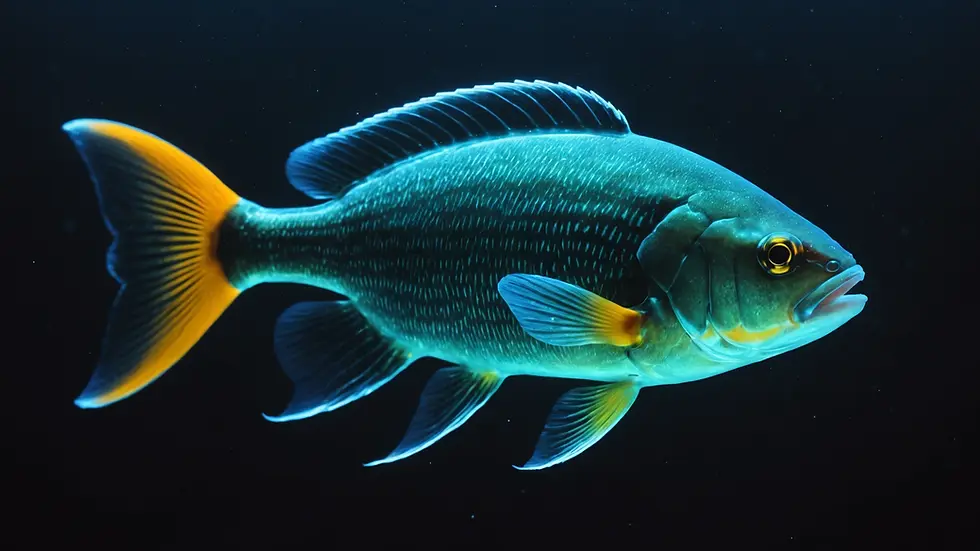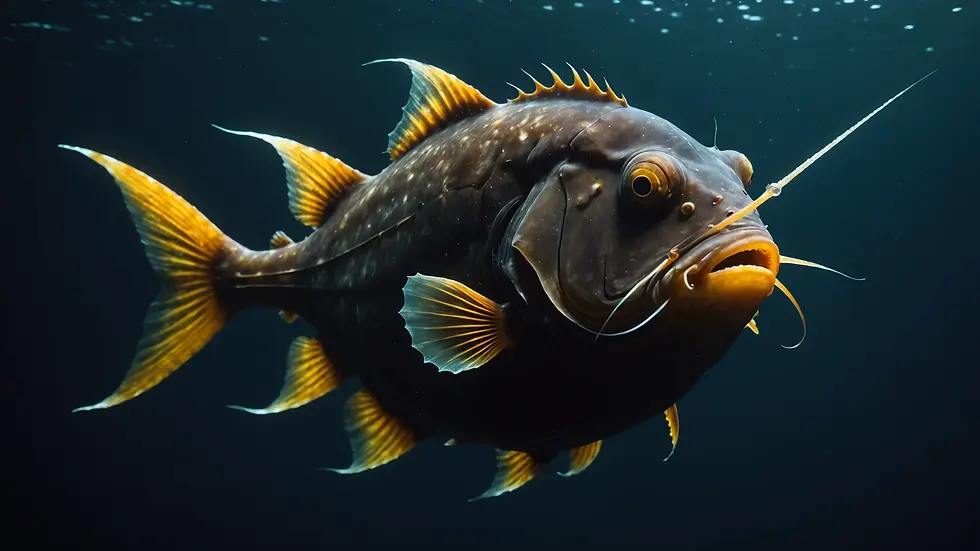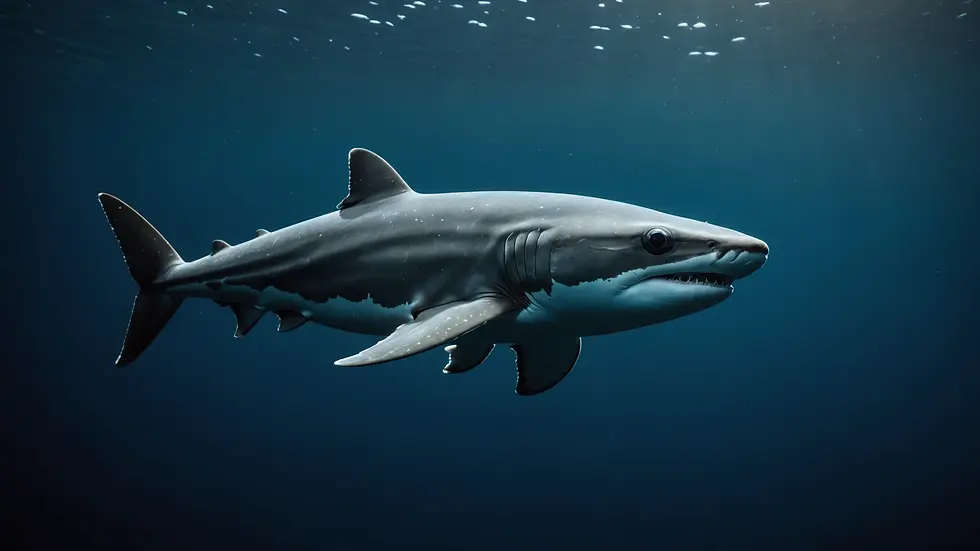Unraveling the Mystery: The Science Behind Bioluminescent Fish
- Jyotiraj Borah
- Feb 5
- 5 min read
Bioluminescence—the natural ability of certain organisms to produce light—is a captivating aspect of nature. It sparks the curiosity of scientists and enthusiasts worldwide. Among the most astonishing examples are bioluminescent fish, which use their glowing abilities for survival in the depths of the ocean. Imagine the enchanting display of light flickering in the dark waters, helping these fish communicate, camouflage, and lure prey.
But what causes some fish to glow while others do not? This post will explore the science behind bioluminescent fish, including the mechanisms behind their glow, notable species, and the roles bioluminescence plays in their lives.
Understanding Bioluminescence
Bioluminescence is a chemical process that allows living organisms to produce light. This occurs through a reaction between a light-emitting molecule called luciferin and an enzyme known as luciferase.
When these two components interact, they generate light often described as "cold light" because it emits little to no heat. This incredible ability is observed not only in fish but also in other organisms such as fungi and bacteria. Interestingly, studies estimate that about 80% of deep-sea marine species possess some form of bioluminescence.
For fish, this glowing ability is essential for survival, playing roles in attracting mates, evading predators, and hunting.
The Mechanisms of Bioluminescence in Fish
In bioluminescent fish, light is typically produced in specialized cells known as photophores. These cells can be located in various parts of the fish's body, such as the skin, organs, or unique appendages.
The Role of Photophores
Photophores are small, bioluminescent organs that contain luciferin and luciferase. In certain species, these organs can alter their color or intensity to facilitate communication or camouflage. The number and arrangement of photophores can significantly differ among species, shaping their interactions with predators and prey.
For example, the lanternfish, known for its abundance in the deep ocean, has numerous photophores along its body. This fish uses its light to blend in with the faint sunlight from above, successfully avoiding predators that hunt in the dark depths. Research has shown that lanternfish make up approximately 65% of the deep sea fish biomass, illustrating their vital role in the ocean ecosystem.
The Chemistry Behind the Glow
The primary reaction leading to bioluminescence occurs when luciferin reacts with oxygen, facilitated by luciferase. This process is efficient, converting almost all the energy into light rather than heat.
Different species utilize various forms of luciferin and luciferase, resulting in a spectrum of colors in bioluminescence. While many marine organisms emit a blue-green light, others can produce yellow, red, or violet light. For instance, the light emitted by certain species of jellyfish, like Aequorea victoria, appears green due to the specific form of luciferin they use.

Types of Bioluminescent Fish
Numerous fish species have adapted bioluminescence into their survival strategies. Here are some noteworthy examples:
Lanternfish
Lanternfish are among the most iconic bioluminescent fish. They thrive in ocean depths and use photophores for communication and camouflage. Their emitted light helps them blend with the dim rays penetrating the surface. With over 240 identified species, lanternfish form a crucial part of the ocean's food chain, serving as prey for larger fish, seabirds, and marine mammals.
Anglerfish
Anglerfish are famous for their luminescent lure that extends from their heads, which hosts bioluminescent bacteria. This unique adaptation acts as bait for unsuspecting prey. In the deep sea, where hunting is challenging, the anglerfish's glow acts as a beacon, attracting curious organisms that become easy targets.
In fact, some anglerfish can grow up to 3 feet long, with their lures extending even more than half their body length, exemplifying the effectiveness of this adaptation.
Cookiecutter Shark
The cookiecutter shark is another captivating example of bioluminescent fish. These small sharks emit light from their bellies, creating a counter-illumination effect that helps them blend into the surrounding water. Furthermore, they can create rapid flashes of light when threatened, disorienting potential predators.
Research indicates that cookiecutter sharks can remove circular plugs of flesh from their prey, showcasing their unique predatory strategies supported by their bioluminescence.

The Reasons Behind Fish Bioluminescence
There are several key functions for fish bioluminescence, including:
Communication
Bioluminescent signals play a crucial role in the communication between fish. For example, some species use varying intensities and colors of their glow to convey messages about danger, mating, or social hierarchy. This complexity adds depth to their interactions, enhancing their social behavior in the wild.
Predation
Many bioluminescent fish use their glow to attract prey. By employing lures and flashing lights, they can entice smaller fish and organisms, making them vulnerable. The cookiecutter shark's bioluminescent glow is particularly effective, drawing in unsuspecting smaller fish.
Camouflage
Counterillumination is essential for survival among bioluminescent fish. By emitting light that matches ambient conditions, these fish effectively camouflage themselves from above. This tactic allows them to avoid predators while stealthily approaching potential prey.
Defense Mechanisms
Some bioluminescent fish use their glow as a defensive tool. When threatened, certain species can release bioluminescent fluid that disorients predators, enhancing their chances of escape. This strategy is vital in balancing life and death in their complex marine ecosystems.

The Impact of Human Activities on Bioluminescent Fish
While bioluminescence is a magnificent natural occurrence, human actions jeopardize these extraordinary species and their habitats.
Climate Change
Rising global temperatures and shifting ocean conditions threaten bioluminescent fish. Changing water temperatures disrupt breeding and feeding cycles, impacting their survival. Additionally, acidification alters the ocean's chemistry, threatening the organisms bioluminescent fish depend on for food.
Overfishing
Overfishing poses significant risks to bioluminescent fish populations. In particular, lanternfish are frequently overcaught for use as animal feed and human consumption. Intensive fishing practices can dramatically reduce their numbers, leading to consequences for the overall marine food chain.
Habitat Destruction
Pollution, coastal development, and unsustainable fishing practices contribute to the destruction of ocean habitats. As these fish depend on specific environments for breeding and survival, habitat loss severely impacts their populations and overall marine biodiversity.
Research indicates that over half of the world's coral reefs are threatened, which also affects bioluminescent fish that rely on these habitats for survival.
A Glimpse into the Future of Bioluminescent Fish
Bioluminescent fish truly showcase the wonders of the natural world and the amazing mechanisms that support life in extreme underwater environments. By studying their chemistry and ecological importance, we gain valuable insights into marine life and the adaptive strategies organisms use to survive.
Raising awareness about these exceptional fish and their vulnerabilities is vital. Protecting their habitats can help ensure future generations can marvel at the mesmerizing glow of bioluminescent species.
As research continues, we may discover even more secrets about these luminous fish and their significance in our oceans, reminding us of the richness and complexity of nature yet to be explored.




Comments